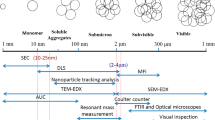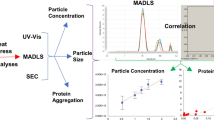Abstract
Purpose
To speed up the drug development process in the biopharmaceutical industry, high throughput methods are indispensable for assessing drug candidates and potential lead formulations, in particular during late stages of discovery and early phases of development. This study aimed to establish a bio-layer-interferometry based high throughput assay for assessing formulation dependent mAb self-interaction (SI-BLI) and to compare the results with kD values obtained by dynamic light scattering (DLS).
Methods
Self-interaction of proprietary and commercially available mAbs was analyzed by SI-BLI and dynamic light scattering (DLS).
Results
We found significant correlations of the SI-BLI results and kD-values obtained by DLS for both, different mAbs in one platform formulation and for mAbs formulated in several buffer compositions. In total, we assessed self-interaction propensity of different mAbs in 58 formulations and found significant Pearson correlation (p < 0.05) between kD and results of SI-BLI.
Conclusions
The SI-BLI results correlate with kD and enable fast ranking of both different drug candidates and potential lead formulations. Thus, SI-BLI might decrease the risk to lose potent mAb candidates during transition from discovery to development, and help to accelerate the development of high concentration liquid formulations.







Similar content being viewed by others
Abbreviations
- AUC:
-
Analytical ultracentrifugation
- BLI:
-
Bio-layer-interferometry
- DLS:
-
Dynamic light scattering
- HCLF:
-
high (protein) concentration liquid formulation
- HDX-MS:
-
Hydrogen-Deuterium exchange mass spectrometry
- mAb:
-
Monoclonal antibody
- PBS:
-
Phosphate buffered saline
- SI-BLI:
-
Self-interaction assay based on Bio-layer-interferometry
- SIC:
-
Self-interaction chromatography
- SLS:
-
Static Light Scattering
References
Ecker DM, Jones SD, Levine HL. The therapeutic monoclonal antibody market. MAbs. 2015;7:9–14.
Shire SJ, Shahrokh Z, Liu J. Challenges in the development of high protein concentration formulations. J Pharm Sci. 2004;93:1390–402.
Yadav S, Liu J, Shire SJ, Kalonia DS. Specific interactions in high concentration antibody solutions resulting in high viscosity. J Pharm Sci. 2010;99:1152–68.
Laue T. Proximity energies: A framework for understanding concentrated solutions. J Mol Recognit. 2012;25:165–73.
Lilyestrom WG, Yadav S, Shire SJ, Scherer TM. Monoclonal antibody self-association, cluster formation, and rheology at high concentrations. J Phys Chem B. 2013;117:6373–84.
Esfandiary R, Parupudi A, Casas-Finet J, Gadre D, Sathish H. Mechanism of Reversible Self-Association of a Monoclonal Antibody: Role of Electrostatic and Hydrophobic Interactions. J Pharm Sci. 2015;104:577–86.
Binabaji E, Ma J, Zydney AL. Intermolecular Interactions and the Viscosity of Highly Concentrated Monoclonal Antibody Solutions. Pharm Res. 2015;32:3102–9.
Connolly BD, Petry C, Yadav S, Demeule B, Ciaccio N, Moore JMR, et al. Weak interactions govern the viscosity of concentrated antibody solutions: High-throughput analysis using the diffusion interaction parameter. Biophys J. 2012;103:69–78.
Le Brun V, Friess W, Bassarab S, Mühlau S, Garidel P. A critical evaluation of self-interaction chromatography as a predictive tool for the assessment of protein-protein interactions in protein formulation development: A case study of a therapeutic monoclonal antibody. Eur J Pharm Biopharm. 2010;75:16–25.
Dear BJ, Hung JJ, Truskett TM, Johnston KP. Contrasting the Influence of Cationic Amino Acids on the Viscosity and Stability of a Highly Concentrated Monoclonal Antibody. Pharm Res. 2017;34:193–207.
Agrawal NJ, Helk B, Kumar S, Mody N, Sathish HA, Samra HS, et al. Computational tool for the early screening of monoclonal antibodies for their viscosities. MAbs. 2016;8:43–8.
Hofmann M, Winzer M, Weber C, Gieseler H. Prediction of Protein Aggregation in High Concentration Protein Solutions Utilizing Protein-Protein Interactions Determined by Low Volume Static Light Scattering. J Pharm Sci Elsevier Ltd. 2016;105:1819–28.
Hedberg SHM, Heng JYY, Williams DR, Liddell JM. Self-Interaction Chromatography of mAbs: Accurate Measurement of Dead Volumes. Pharm Res. 2015;32:3975–85.
Liu Y, Caffry I, Wu J, Geng SB, Jain T, Sun T, et al. High-throughput screening for developability during early-stage antibody discovery using self-interaction nanoparticle spectroscopy. MAbs. 2014;6:483–92.
Estep P, Caffry I, Yu Y, Sun T, Cao Y, Lynaugh H, et al. An alternative assay to hydrophobic interaction chromatography for high-throughput characterization of monoclonal antibodies. MAbs. 2015;7:553–61.
Saito S, Hasegawa J, Kobayashi N, Kishi N, Uchiyama S, Fukui K. Behavior of Monoclonal Antibodies: Relation between the Second Virial Coefficient (B2) at Low Concentrations and Aggregation Propensity and Viscosity at High Concentrations. Pharm Res. 2012;29:397–410.
Hopkins MM, Lambert CL, Bee JS, Parupudi A, Bain DL. Determination of Interaction Parameters for Reversibly Self-Associating Antibodies: A Comparative Analysis. J Pharm Sci Elsevier Ltd. 2018;107:1820–30.
Sun T, Reid F, Liu Y, Cao Y, Estep P, Nauman C, et al. High throughput detection of antibody self-interaction by bio-layer interferometry. MAbs. 2013;5:838–41.
Zhang Z, Liu Y. Recent progresses of understanding the viscosity of concentrated protein solutions. Curr Opin Chem Eng Elsevier Ltd. 2017;16:48–55.
Liu J, Nguyen MDH, Andya JD, Shire SJ. Reversible self-association increases the viscosity of a concentrated monoclonal antibody in aqueous solution. J Pharm Sci. 2005;94:1928–40.
Li L, Kumar S, Buck PM, Burns C, Lavoie J, Singh SK, et al. Concentration dependent viscosity of monoclonal antibody solutions: Explaining experimental behavior in terms of molecular properties. Pharm Res. 2014;31:3161–78.
Yadav S, Scherer TM, Shire SJ, Kalonia DS. Use of dynamic light scattering to determine second virial coefficient in a semidilute concentration regime. Anal Biochem. 2011;411:292–6.
Tomar DS, Kumar S, Singh SK, Goswami S, Li L. Molecular basis of high viscosity in concentrated antibody solutions: Strategies for high concentration drug product development. MAbs. 2016;8:216–28.
Sorret LL, DeWinter MA, Schwartz DK, Randolph TW. Challenges in Predicting Protein-Protein Interactions from Measurements of Molecular Diffusivity. Biophys J Biophysical Society. 2016;111:1831–42.
Arora J, Hu Y, Esfandiary R, Sathish HA, Bishop SM, Joshi SB, et al. Charge-mediated Fab-Fc interactions in an IgG1 antibody induce reversible self-association, cluster formation, and elevated viscosity. MAbs. 2016;8:1561–74.
Arora J, Hickey JM, Majumdar R, Esfandiary R, Bishop SM, Samra HS, et al. Hydrogen exchange mass spectrometry reveals protein interfaces and distant dynamic coupling effects during the reversible self-association of an IgG1 monoclonal antibody. MAbs. 2015;7:525–39.
Kanai S, Liu J, Patapoff TW, Shire SJ. Reversible Self-Association of a Concentrated Monoclonal Antibody Solution Mediated by Fab–Fab Interaction That Impacts Solution Viscosity. J Pharm Sci. 2008;97:4219–27.
Geng SB, Wittekind M, Vigil A, Tessier PM. Measurements of Monoclonal Antibody Self-Association Are Correlated with Complex Biophysical Properties. Mol Pharm. 2016;13:1636–45.
Hedberg SHM, Heng JYY, Williams DR, Liddell JM. Micro scale self-interaction chromatography of proteins: A mAb case-study. J Chromatogr A. 2016;1434:57–63.
Yang D, Correia JJ, Iii WFS, Roberts CJ, Singh S, Hayes D, et al. Weak IgG self and hetero-association characterized by fluorescence analytical ultracentrifugation. Protein Sci. 2018;27:1334–48.
Acknowledgements
This study was part of the project “Self-Interaction and targeted Engineering of monoclonal antibodies (Self-I-E)”. This project is funded by the Bayerische Forschungsstiftung. The authors would like to thank the whole Protein Sciences & CMC Department of MorphoSys AG for their outstanding support. In addition, the authors would like to thank Dr. Daniel Weinfurtner and Dr. Roy Eylenstein for their support during the initial phase of this project.
Author information
Authors and Affiliations
Corresponding author
Additional information
Guest Editors: Ahmed Besheer and Hanns-Christian Mahler
Publisher’s Note
Springer Nature remains neutral with regard to jurisdictional claims in published maps and institutional affiliations.
Electronic supplementary material
ESM 1
(DOCX 39 kb)
Rights and permissions
About this article
Cite this article
Domnowski, M., Jaehrling, J. & Frieß, W. Assessment of Antibody Self-Interaction by Bio-Layer-Interferometry as a Tool for Early Stage Formulation Development. Pharm Res 37, 29 (2020). https://doi.org/10.1007/s11095-019-2722-4
Received:
Accepted:
Published:
DOI: https://doi.org/10.1007/s11095-019-2722-4




